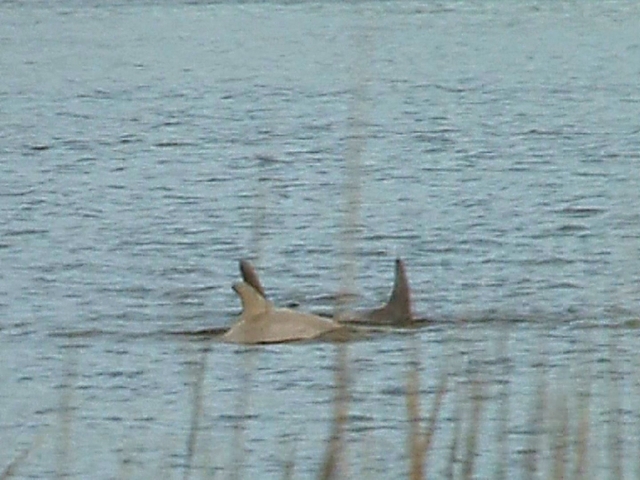
A young white dolphin has surfaced near the Wappoo Creek bridge on Folly Road most afternoons the past few weeks, wowing spectators, including diners at the Charleston Crab House, who jump from their seats to the window and deck outside.
"They go crazy. They scream," said owner John Keener. "It runs right alongside its mom all the time."
Jim Mossman, a videographer for the city of Charleston, inadvertently might have shot a video of the baby in January, while capturing a pod in the Ashley River near the West Ashley Bikeway. The smaller dolphin's coloring drew him, he said. "I don't think I've ever seen a baby dolphin, much less a white one."
An albino dolphin is an eye-catcher, but the animal will have a tough go in the wild. Still, its appearance is a heart-warmer in a year when a virus has been decimating the population. More than 1,000 dolphin have died so far, more than 100 in South Carolina alone. And a second wave of the virus-caused deaths is expected as waters warm.
Albinism is a genetic abnormality in which the skin pigment has no coloring. Among humans it affects one of every 17,000 people and is associated with eyesight difficulties, according to the National Organization for Albinism and Hypopigmentation.
It's also found in any number of animals. Among mammals generally it's thought to occur one in every 10,000 births, according to National Geographic.
Any number of Lowcountry animals are albino or have white pigment that suggests albinism. White squirrels are found on Yonges Island, Johns Island and in other locations. Kiawah Island has had occurrences of white deer and raccoons.
A young white dolphin captured recently during a hunt off Japan, while its mother leaped, called out, then sank and died. The young dolphin was sold to a museum, stirring an international outcry.
The Lowcountry's own notorious albino dolphin, "Snowball," was captured near Beaufort in the 1960s and sold to a Florida attraction. The outcry from that was one of the factors that led to the state's Marine Mammal Act in the 1990s, that banned the animals' capture for display.
Some native traditions in the United States hold that albino animals are sacred, literally closer to spiritual. But in the natural world, white stands out and that's not good. Pigment not only protects the skin from sun damage, it's one of the ways animals of the same species recognize each other, and it's camouflage from predators, said Moby Solangi, director of the Institute for Marine Mammal Studies in Gulfport, Miss. One of the big predators of bottlenose dolphin are sharks.
The young dolphin should be all right as long as it's protected by its mother, he said. But "it's a tough situation for an albino to survive in their world. Some live pretty long and others don't make it too long."
Dolphin virus
Morbillivirus: Measles-like virus that weakens and can kill whales, dolphins and porpoises.
Deaths so far:
S.C. 105 (July 1, 2013- March 16)
Average deaths in same time span 28
East Coast overall 1,175
Average 169
Last outbreak: 750 deaths, 1987-88.
Prognosis: A second wave of deaths is expected as waters warm. But, if the 1987-88 outbreak is a any guide, a slowdown is expected.
If you see a stranded dolphin or other marine mammal:
Don't approach it or let pets approach it. Don't try to push the animal back into the water.
The morbillivirus isn't contagious, but a weakened dolphin can contract other infections. Stranded dolphins and other marine mammals are often sick, and some diseases can be spread to humans or pets.
Contact the Marine Mammal Stranding Network hotline, 1-800-922-5431.
Source: NOAA Fisheries



Reader Comments
to our Newsletter